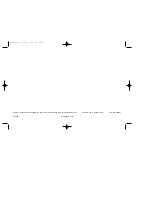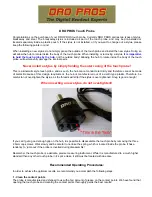
2
•
CHECK DAMAGED PARTS. Before further use of the tool, a guard
or other part that is damaged should be carefully checked to
determine that it will operate properly and perform its intended
function. Check for alignment of moving parts, binding of moving
parts, breakage of parts, mounting, and any other conditions that
may affect its operation. A guard or other part that is damaged
should be properly repaired or replaced by an authorized service
center unless otherwise indicated elsewhere in this instruction
manual. Have defective switches replaced by authorized service
center. Do not use tool if switch does not turn it on and off.
SAVE THESE INSTRUCTIONS
Motor
Your D
E
Walt tool is powered by a D
E
Walt-built motor. Be sure your power
supply agrees with the nameplate marking.
Volts 50/60 Hz or “AC only” means your tool must be operated on
alternating current and never with direct current.
Voltage decrease of more than 10% will cause loss of power and
overheating. D
E
Walt tools are factory tested; if this tool does not operate,
check power supply.
Switch
Depress the trigger switch to turn the tool on. Releasing the trigger
turns the tool off. To lock the trigger in the on position for continuous
operation, depress the trigger, push in the lock button on the left
side of the handle, and then release the trigger. To release the
locking mechanism, depress trigger fully, then release it.
English
Operation
1. For accurate work, be sure material to be cut is anchored firmly.
2. Grasp tool and turn switch on.
3. WITHOUT LETTING BLADES ENGAGE THE MATERIAL,
position tool so that the material rests on the top of the front edge
of the shoe.
4. Line up tool with the cutting line and advance tool into the
material. Use a firm forward pressure when cutting, but do not
force the tool.
NOTE: If tool does not cut efficiently, check the following: dull
blades, blades incorrectly set, material which exceeds the rated
capacity of the tool.
Blade Adjustment
TURN OFF TOOL AND DISCONNECT FROM POWER SUPPLY
BEFORE ADJUSTING BLADES.
HORIZONTAL CLEARANCE: The setting of the horizontal
clearance between blades depends upon the capacity of the tool and
the thickness of the material being cut. When cutting sheet steel,
clearance should not be over .009". When cutting lighter material, the
clearance should be reduced in proportion.
VERTICAL CLEARANCE: Position the moving blade at the top of its
stroke. Adjust the vertical clearance so that the material to be cut can
be inserted 1/2 way into the “V” shaped opening.
NOTE: After adjusting horizontal and vertical clearances, rotate fan
manually to ensure that the blades do not interfere during any portion
of the stroke.
DW895/384483 5/2/02 1:11 PM Page 2



































